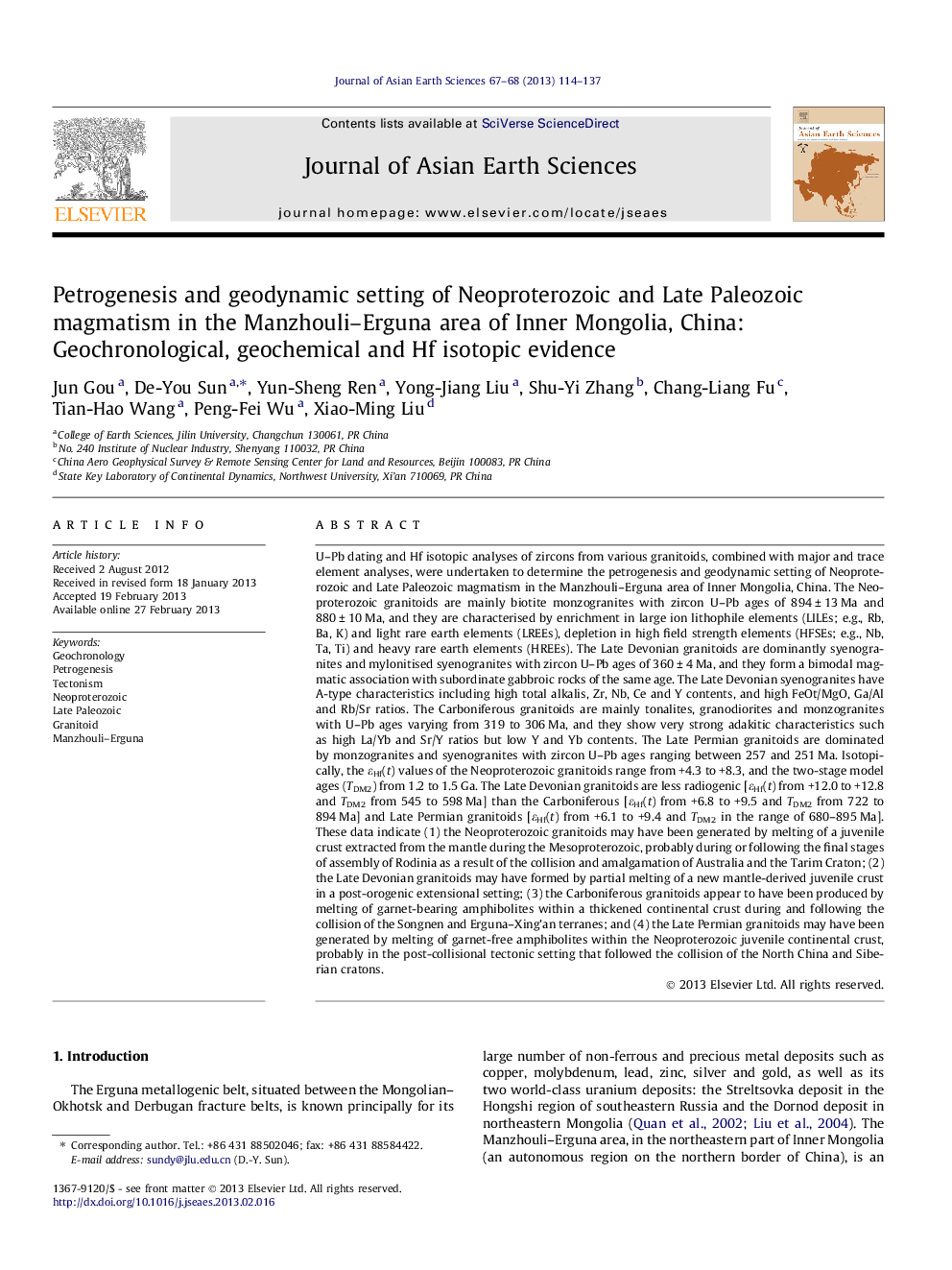| Article ID | Journal | Published Year | Pages | File Type |
|---|---|---|---|---|
| 4731130 | Journal of Asian Earth Sciences | 2013 | 24 Pages |
U–Pb dating and Hf isotopic analyses of zircons from various granitoids, combined with major and trace element analyses, were undertaken to determine the petrogenesis and geodynamic setting of Neoproterozoic and Late Paleozoic magmatism in the Manzhouli–Erguna area of Inner Mongolia, China. The Neoproterozoic granitoids are mainly biotite monzogranites with zircon U–Pb ages of 894 ± 13 Ma and 880 ± 10 Ma, and they are characterised by enrichment in large ion lithophile elements (LILEs; e.g., Rb, Ba, K) and light rare earth elements (LREEs), depletion in high field strength elements (HFSEs; e.g., Nb, Ta, Ti) and heavy rare earth elements (HREEs). The Late Devonian granitoids are dominantly syenogranites and mylonitised syenogranites with zircon U–Pb ages of 360 ± 4 Ma, and they form a bimodal magmatic association with subordinate gabbroic rocks of the same age. The Late Devonian syenogranites have A-type characteristics including high total alkalis, Zr, Nb, Ce and Y contents, and high FeOt/MgO, Ga/Al and Rb/Sr ratios. The Carboniferous granitoids are mainly tonalites, granodiorites and monzogranites with U–Pb ages varying from 319 to 306 Ma, and they show very strong adakitic characteristics such as high La/Yb and Sr/Y ratios but low Y and Yb contents. The Late Permian granitoids are dominated by monzogranites and syenogranites with zircon U–Pb ages ranging between 257 and 251 Ma. Isotopically, the εHf(t) values of the Neoproterozoic granitoids range from +4.3 to +8.3, and the two-stage model ages (TDM2) from 1.2 to 1.5 Ga. The Late Devonian granitoids are less radiogenic [εHf(t) from +12.0 to +12.8 and TDM2 from 545 to 598 Ma] than the Carboniferous [εHf(t) from +6.8 to +9.5 and TDM2 from 722 to 894 Ma] and Late Permian granitoids [εHf(t) from +6.1 to +9.4 and TDM2 in the range of 680–895 Ma]. These data indicate (1) the Neoproterozoic granitoids may have been generated by melting of a juvenile crust extracted from the mantle during the Mesoproterozoic, probably during or following the final stages of assembly of Rodinia as a result of the collision and amalgamation of Australia and the Tarim Craton; (2) the Late Devonian granitoids may have formed by partial melting of a new mantle-derived juvenile crust in a post-orogenic extensional setting; (3) the Carboniferous granitoids appear to have been produced by melting of garnet-bearing amphibolites within a thickened continental crust during and following the collision of the Songnen and Erguna–Xing’an terranes; and (4) the Late Permian granitoids may have been generated by melting of garnet-free amphibolites within the Neoproterozoic juvenile continental crust, probably in the post-collisional tectonic setting that followed the collision of the North China and Siberian cratons.
► Neoproterozoic granitoids generated by melting of a Mesoproterozoic juvenile crust. ► Late Paleozoic granitoids were derived from juvenile Neoproterozoic crusts. ► Late Devonian magmatism was formed in a post-orogenic extensional setting. ► Carboniferous magmatism was associated with assembly of Xing’an and Songnen terranes. ► Late Permian magmatism was induced by collision of Siberia and North China cratons.
